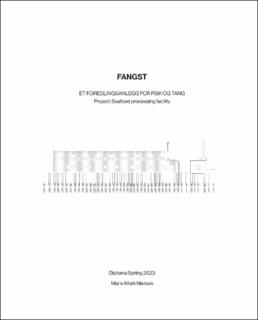FANGST - Et foredlingsanlegg for fisk og tang
Master thesis
Submitted version

Permanent lenke
https://hdl.handle.net/11250/3074715Utgivelsesdato
2023-06Metadata
Vis full innførselSamlinger
Beskrivelse
With the case of Vardø, my diploma investigates the current problems with the fish industry and suggests a strategy to reinhabit and strengthen the coastal settlement through symbiosis between small-scale fishing and seaweed cultivation.
After many years of depression and dilapidation in Vardø, the backdrop of my diploma comes with a local urgency to reinhabit the harbor and preserve the use of harbor buildings for the fish industry. With the urgent need to put the buildings in Vardø harbor back into operation, the project investigates how a vacant harbor building can be transformed and reused to house future industry to bring back local workplaces. How does the merge between the traditional coastal architecture and the new industrial demands inform architectural space?
Traditionally the coastal people in the north subsisted through a combination of fishing and farming, in Norwegian called fiskarbonden. The combination of two sources of nutrition and income provided families with what they needed to secure the settlement. Learning from our history, my exploration for the future comes from an inspiration of historical traditions. The project further investigates how the industry of small-scale fishing can be expanded and strengthened through symbiosis with a new, up and coming industry; seaweed farming. The aim is to expand the seafood industry in a more diverse and sustainable direction, that can bring back local workplaces for processing and open up for greater participation across gender and age.
The facility covers the entire production line from harvest to finished product, and the goal is to keep processing and as much raw materials as possible locally. The products can be bought at the local shop inside the old cod liver oil factory, Sea Fever. On the upper floor you can enjoy a healthful seaweed bath with cut off from the production.
